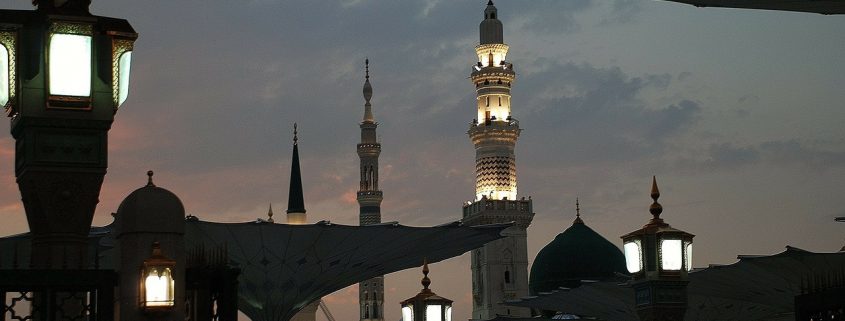The history of Mecca before the rise of Islam is obscure. With all due respect to Muslims, their historians have tended to retcon—shorthand for “retroactive continuity,” a Hollywood term for changing the backstory of a television series or movie franchise—the history of lands occupied by Islam. It is an inconvenient truth for Muslims that there are no clear references to Mecca in any text known to scholars written before the eighth century AD.
You’ll probably be surprised to learn that the Quran only mentions Mecca once. Given the significance of Mecca today, how is that possible? Imagine the Bible with only one reference to Jerusalem! There is more to the story of how Mecca became the holy site of Islam than we are told.
A second reference in the Quran, Becca, is assumed by most people to mean Mecca, but it’s not necessarily a synonym for the city. Muslim scholars distinguish between the two: Becca is the holy site surrounding the Ka’ba, while Mecca is the city in which Becca is located.
Additionally, Quranic descriptions of the city just don’t fit the actual geography of Mecca. For example, the Quran and hadiths (purported sayings of Muhammad collected after his death) describe it as a city in a valley with a “rain water passage” between two mountains, where grass and trees once grew—none of which is supported by archaeology. Mecca is in a barren valley unsuited for raising crops or herds.
Taken together, the evidence strongly suggests that the Ka’ba was not in Mecca during the lifetime of Muhammad.
Further, tales of Mecca as a thriving center of trade in Muhammad’s day aren’t supported by documented history. By the sixth century AD, the ancient world’s demand for incense had evaporated with the spread of Christianity. Unlike the pagan gods, Jesus never asked His followers to honor Him with offerings of frankincense and myrrh. As the faith spread, demand for spices and incense dried up. The few camel caravans that still carried such goods from southern Arabia traveled a road that bypassed Mecca altogether.
Muslim histories trace the origin of Mecca to the descendants of Ishmael. But the Romans, who took control of western Arabia from the Nabataean Arabs in the second century AD, seem to have been completely unaware of a place called Mecca. It wasn’t until AD 741 that Mecca is mentioned in a foreign text, and that author located it in Mesopotamia, halfway between Ur and Harran in what is now Iraq.
For context, by AD 741, a little more than a hundred years after Muhammad’s death, the armies of Islam had conquered Persia, Mesopotamia, Egypt, north Africa, most of Anatolia (modern Turkey), and the Visigothic kingdom in Spain. Between 674 and 678, an Islamic army laid siege to Constantinople, the capital city of the Eastern Roman Empire.
Yet, Mecca was so unimportant that the Western world didn’t know where it was!
How is that possible?
Here’s another bit of data to chew on: It’s well known that Muslims are expected to pray in the direction of Mecca five times a day. This is called the Qibla (Arabic for “direction”). Most mosques have a niche built into a wall that indicates the direction of the Ka’ba in Mecca.
Note the word “most.” Not all—most.
It’s known from the Quran that the Qibla was changed during the lifetime of Muhammad. If Mecca wasn’t the original target of Muslim prayers, what was?
Jerusalem.
According to Yunus b. ‘Abd al-A‘la—Ibn Wahb—Ibn Zayd: The Prophet turned towards Jerusalem for sixteen months, and then it reached his ears that the Jews were saying, “By God, Muhammad and his companions did not know where their Qiblah was until we directed them.” This displeased the Prophet and he raised his face toward Heaven, and God said, “We have seen the turning of your face to Heaven.”
So, around AD 624, the Qibla shifted from Jerusalem to Mecca. It was not just for sixteen months, but more than thirteen years—the time Muhammad preached in Mecca plus sixteen months in Medina—that Muhammad taught his followers to pray towards Jerusalem.
Canadian historian and author Dan Gibson decided to test that belief several years ago by measuring the orientation of the Qibla in the oldest mosques still standing. Using modern satellite photography, GPS, and other architectural tools, he found, to his surprise, that mosques built during the first hundred years of Islam were not oriented toward Mecca.
But they don’t face Jerusalem, either.
Of the twelve surviving mosques for which Gibson could obtain reliable data, all are oriented toward Petra, the fabulous Nabataean city carved into the red sandstone cliffs of southern Jordan. The largest error in alignment, the Qaṣr Humeima mosque in Jordan, is off by only 7.3 degrees from Petra, and the average error for the twelve mosques is only 2.5 degrees, one of which is in China! The oldest of the mosques was built in Medina in AD 626, six years before Muhammad’s death and four years before he and his followers captured Mecca.
The first known mosque to orient its Qibla in the direction of Mecca was built in AD 727, more than a century after Muslim scholars acknowledge the Qibla changing from Jerusalem.
If correct, this is stunning. It would mean two things: First, Muhammad didn’t teach his followers to pray toward Mecca because his “Mecca” was not the one in Arabia. Second, and more surprising, is that the change in the Qibla directed Muslims to revert to the veneration of a pagan object—a Ka’ba (“cube”) in the city of Petra.
Gibson believes the first Ka’ba may have been in front of the temple of Dushara, the chief god of the Nabataeans. After the death of the Umayyad caliph Mu’awiya in AD 680, one of the last of Muhammad’s surviving companions, Abdullah ibn al-Zubayr, refused to swear allegiance to the new amir, Yazid. By 683, out of patience with the rebel, Yazid dispatched a force from Damascus to Medina that defeated and slaughtered the followers of Ibn al-Zubayr—but their leader had left town before the amir’s army arrived. Ibn al-Zubayr had decided to hole up in the bayt allah, “House of God,” apparently daring the new caliph to desecrate it by launching an assault against the faithful barricaded inside.
To this day, Muslims assume the “House of God” was the Ka’ba in Mecca, but no contemporary writings say so. In fact, the clues point farther north.
The weight of evidence would suggest a location to the north of the Hijaz, midway between Kufa and Alexandria. Since this is precisely the region with which Muhammad himself appears to have been most familiar, and since Ibn al-Zubayr was consciously aiming to defend the Prophet’s legacy, the likelihood must surely be that the House of God in which he barricaded himself stood not in Mecca but between Medina and Palestine: in that “blessed place” named by the Prophet himself as Bakka.
At the risk of stating the obvious: Petra is north of the Hijaz between Medina and Palestine. Unlike Mecca, it fits the Quran’s descriptions of Islam’s holy city. Petra is a settlement in a valley with a “rainwater passage” between two mountains where grass and trees once grew.
There’s another link between Petra and Mecca. The fourth-century Christian bishop Epiphanius, from Salamis on the island of Cyprus, is best-known for his book Panarion, written between AD 374 and 377. The book is a refutation of eighty heresies, a sort of guidebook to Christian apologetics. Among the pagan beliefs he railed against was the religion of the Nabataeans.
First, at Alexandria, in the Coreum, as they call it; it is a very large temple, the shrine of Core [the Greek goddess Persephone]. They stay up all night singing hymns to the idol with a flute accompaniment. And when they have concluded their nightlong vigil torchbearers descend into an underground shrine after cockcrow and bring up a wooden image which is seated naked < on > a litter.… And they carry the image itself seven times round the innermost shrine with flutes, tambourines and hymns, hold a feast, and take it back down to its place underground. And when you ask them what this mystery means they reply that today at this hour Core—that is, the virgin—gave birth to Aeon.
This is also done in the same way in the city of Petra, in the temple of the idol there. (Petra is the capital city of Arabia, the scriptural Edom.) They praise the virgin with hymns in the Arab language calling her, in Arabic, Chaamu—that is, Core, or virgin. And the child who is born of her they call Dusares, that is, “the Lord’s only-begotten.”
There are two important takeaways from this text. First, the ritual at Alexandria involved circumambulating a shrine seven times. Take note; we’ll refer back to that later.
Second, the ritual at Petra involved the chief deity of the Nabataeans, Dushara, and the tribes of northern Arabia worshiped the god with a ritual circumambulation.
But while Epiphanius meant well, he lost something important in translation.
It appears that Epiphanius confused the Arabic word ka’ba, which means “stone, cube, betyl,” with words such as ka’iba or ku’ba, which mean “young females” or “female breasts.” Because of this confusion, Epiphanius concluded that Dushara was born from a virgin, misinterpreting Dushara’s actual worship in the form of a stone.
A betyl (pronounced “beetle”) is a sacred stone believed by pagans to be endowed with life. So, the chief god of Petra wasn’t born of a virgin; the hymns of praise were for Dushara because he was a stone cube—the ka’ba. The remnant of a stone cube sits in the forecourt of Dushara’s temple in Petra to this day, and visitors pass several massive sandstone cubes called djinn blocks (actually funerary monuments) between the entrance to Petra and the Bab al-Siq, the narrow gorge that leads to the Treasury building made famous by Indiana Jones and the Last Crusade.
According to Epiphanius, the faithful worshiped Dushara by walking in circles around the stone cube.
Does that sound familiar?

Derek Gilbert Bio
Derek P. Gilbert hosts SkyWatchTV, a Christian television program that airs on several national networks, the long-running interview podcast A View from the Bunker, and co-hosts SciFriday, a weekly television program that analyzes science news with his wife, author Sharon K. Gilbert.
Before joining SkyWatchTV in 2015, his secular broadcasting career spanned more than 25 years with stops at radio stations in Philadelphia, Saint Louis, Little Rock, and suburban Chicago.
Derek is a Christian, a husband and a father. He’s been a regular speaker at Bible prophecy conferences in recent years. Derek’s most recent book is The Great Inception: Satan’s PSYOPs from Eden to Armageddon. He has also published the novels The God Conspiracy and Iron Dragons, and he’s a contributing author to the nonfiction anthologies God’s Ghostbusters, Blood on the Altar, I Predict: What 12 Global Experts Believe You Will See by 2025, and When Once We Were a Nation.





Leave a Reply
Want to join the discussion?Feel free to contribute!